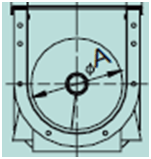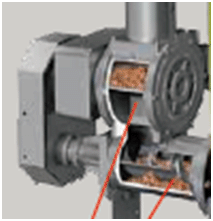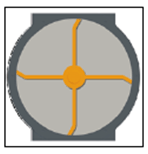The objective of the fuel handling system is to transfer the fuel from the storage tank to the boiler in the right quantity at the right time. At the same time it should also act as a separation between the fuel storage area and the boiler, to prevent the fire in the boiler back-burning into the fuel storage area.
For most domestic or commercial boiler systems the transfer of fuel from the storage area to the boiler is carried out by augers, typically a very long screw encased in piping. The diameter of the screw depends on the size and the amount of fuel to be transported. For wood pellets the auger it can be less than for wood chips.
If there are changes in the direction that the fuel has to travel then normally several augers are used. The first one transports the fuel slightly upwards, to that it can drop it onto the next auger that is aligned in another direction. It is important that the size of augers remains the same or increases in diameter from start to finish. If the auger decreases in size, the risk of blockage increases because the first auger may carry particles that are too large for others in the line.
Augers should be accessible and easy to open, so that any blockage can be removed without too much delay.
Longer augers should only be fixed at the end where the motor is attached to the auger. At the other end the auger should rest in a kind of U shaped bed of bronze. The shape of the auger tube should be like a U with a lid (Figure 7).

Figure 7 Screw conveyor in a U-shaped trough
If a large particle enters the auger, the particle can ride on top of the auger or if it might come under the auger, the auger can lift up to let the oversize particle pass.
To summarise: the fuel handling line should be as short as possible with as few changes of direction as possible. The auger should be adapted in size to the fuel type and the amount that has to be moved to the boiler.
In the fuel feeding system and at a distance from the boiler there should be a sensor that will detect any back burn. If back burn is detected a sprinkler will activate automatically to douse fire. The boiler has to be restarted manually after the wet fuel has been removed. The valve that admits the water should be checked regularly to see if it functions ok, especially that it closes properly after use. If the valve does not close properly, the fuel will get so wet that the fire in the boiler will go out. This is especially the case with wood pellets which swell up when they come in contact with water and will totally block the feeding system.
Another way to avoid any back burn to the storage area is by the use of an air sluice. The fuel is transported upward by the next to last auger and dropped in a box where there is a rotor with four wings. The space between the wings is only open when it passes the top or the bottom of the box, so that the system is air tight when the opening is at the sides of the box. This system prevents eventual back burn to spread to the fuel storage (Figure 8).


Figure 8 Fuel sluice to prevent back burn
